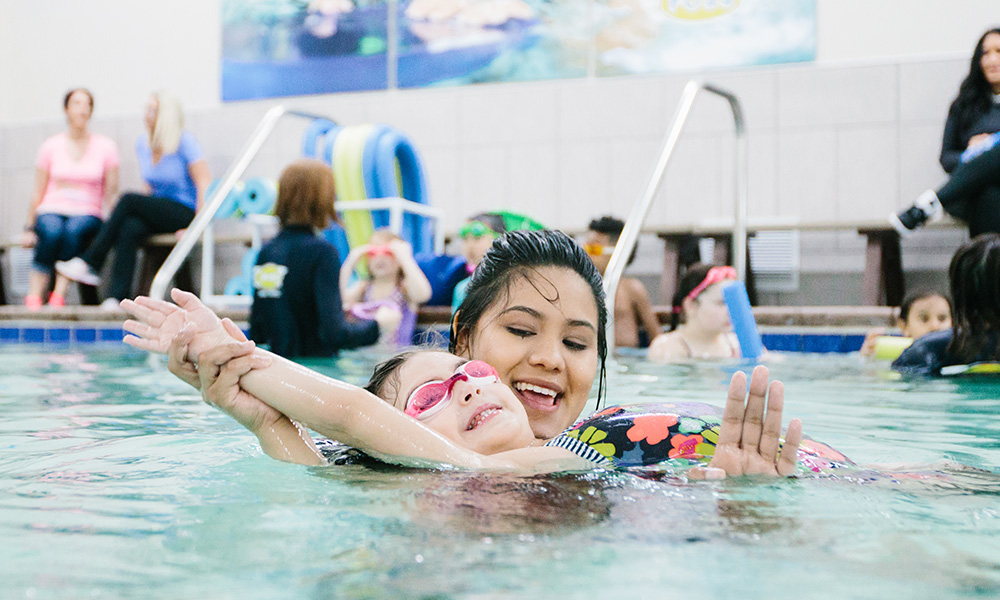For many parents, a core reason to enroll in swim lessons is safety—helping their kids gain enough swimming skill to increase their chances of getting to safety and safely exiting the water in an emergency.
At Foss Swim School we agree wholeheartedly. That’s why our program is designed to produce strong, confident swimmers with a level of skill that will improve their safety significantly in the widest range of likely situations where children are at risk of drowning. For us, that means being able to swim 300 yards, and confidently swim all four main strokes: freestyle (also known as the front crawl), backstroke, breaststroke, and butterfly.
Strokes for safety
Some parents wonder why all strokes are necessary for their child—“It’s not like they’re going to be an Olympic swimmer,” is a common comment.
While we certainly would love to see more kids swim competitively—you can read about all the great benefits of swim teams here—that isn’t the main point of learning all four strokes in our minds, or why we consider them fundamental skills that need to be learned to truly graduate from Foss Swim School.
The safety story behind the strokes
Each of the four primary strokes gives your child another tool and skill to help them reach safety. Especially in outdoor swimming, distances to safety will be far greater than in a pool, and water will be moving—this means the safest swimmers will have strength and stamina. Even in a pool, swimmers in trouble might find themselves needing to draw on more advanced swim skills—they may be tired or have experienced some kind of problem that means they can’t just get to the edge effortlessly.
Here’s how each stroke helps swimmers be safer:
Freestyle: Also known as the front crawl, this stroke offers the cornerstone of swimming. It uses hands and feet efficiently for propulsion, and when done correctly, teaches kids how to breathe while still moving forward.
- Faster and farther: Kids who can swim freestyle can swim farther, faster and use their energy most efficiently to get to safety.
- Side breath: Freestyle utilizes the side breath technique which allows swimmers to get a breath while maintaining propulsive feet and hands.
Breaststroke: The breaststroke uses all four limbs for propulsion at once. The timing is key to maximum efficiency in the breaststroke.
- Face-forward: Because the arms pull simultaneously, breaststroke uses a pop-up face forward breathing technique. This allows the swimmer ability to see where they are going if needed.
- Slow and steady: The Breaststroke cycle is slower than other strokes in an effort to use a long glide to accelerate forward. These long glides can be extremely beneficial if the swimmer is fatigued from the overuse of freestyle or backstroke in a safety situation.
- Fresh muscles: The glide power in the breaststroke kick is developed by working the muscles in the shin, a muscle typically only used in this stroke.
Butterfly: The butterfly is one of the more complicated strokes. It is fast, but not as fast as the freestyle, and less efficient. So why do we teach it? Simple: To build strength and stamina.
- Balanced strength: The two-arm recovery of the butterfly works muscle groups in the upper back and shoulders that are not typically worked in the other three strokes. This balanced muscle growth not only makes the swimmer stronger but also makes them less prone to injury by working all parts of the body, rather than one.
- Swimming confidence: This may not be the stroke of choice in an emergency, but a child who can swim the butterfly well is strong, confident and comfortable in the water.
Backstroke: This isn’t just the reverse of freestyle. It also uses hands and feet efficiently, but uses different muscles, making it a good alternative to freestyle when tired and for long distances.
- Breathe deep: It also allows long, deep breaths. One of the first safety skills we teach kids is to flip on their back to breathe, and the backstroke continues that skill.
- Different muscles: While freestyle uses primarily biceps to gain leverage on the forward pull, backstroke uses triceps to push the swimmer backwards through the water.
Learn all four strokes for safety
Of course, it takes time to learn all four strokes, and even then, there is no such thing as “drown-proof.” Instead, there is an ongoing continuum of safety. Our program at FOSS is designed to improve safety every step of the way.
Your child may not ever be an Olympic swimmer, or swim competitively, but once they know all four strokes, their improved safety and your comfort around the water will make your entire family feel more comfortable and prepared to enjoy water! See you at the pool!
